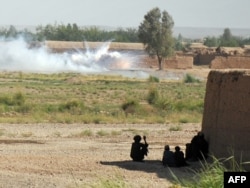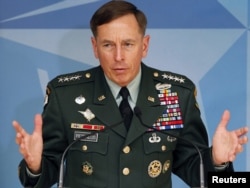KANDAHAR -- Abdul Ghaffar is a living portrait of the misery that has befallen a people caught in the crossfire of war.
Most summer days, Ghaffar can be found tending the fields around his native village of Loai Masjid, located in the volatile Sangin district of Afghanistan's southern Helmand Province. But on this day he is at a hospital in the southern city of Kandahar, keeping watch over his injured son and nephew, and five other village children.
Despite their injuries, they could be described as the lucky ones. They survived an alleged NATO rocket attack that struck the neighboring village where they had gone for shelter on July 23. Last weekend, 17 members of Ghaffar's extended family were buried, including three sisters, three daughters, and one son.
All in all, some 50 Afghan civilians from Loai Masjid and the neighboring village, Regey, died in the attack.
Ghaffar and his fellow villagers would not have been in Regey at all had the Taliban, which occasionally shelters in Loai Masjid, not ordered Ghaffar's and six other families to leave their village that morning. Expecting a NATO military strike on Loai Majid, the Taliban wanted the village evacuated.
The destination was Regey, a small farming village located just kilometers away among rolling hills and bound by rivers on two sides. Regey was considered safe, because the Taliban never used it as a hideout.
Residents provided their fellow villagers from Loai Majid with a compound to shelter women and children, while the men moved to the mosque to pray and rest away from the hot summer sun.
'Spared Death'
The calm was broken in the afternoon by approaching tanks and airplanes, Ghaffar says. "After we offered our [afternoon] prayers, we heard gunfire," he says. "We couldn't tell where it was coming from, it was not too loud.
"But after a minute or two, we heard a big explosion nearby. We could hear airplanes flying overhead, but couldn't tell where, exactly, the explosion happened."
Terrified screams soon followed, leading Ghaffar and others to rush toward the mud compound where their families had been sheltering since morning.
"The eastern side of the building was completely destroyed and so was the northern part. And these children [here in the hospital] were in the southern part of the house," Ghaffar says.
"We found half the dead bodies when we took out these seven injured children from the rubble. My brother told me, 'Take these children to the hospital so they can be spared death.'"
New Commander, Same Problem
NATO continues to investigate the incident, together with the Afghan authorities. But Afghan President Hamid Karzai wasted no time condemning the killing of Afghan civilians.
A July 26 statement from the presidential palace said that Afghan intelligence reports established that 52 people had been killed in a NATO rocket attack. "The president condoled via phone with the mourning families and called on NATO troops to put into practice every possible measure to avoid harming civilians during military operations," the statement read.
The call for caution came on a day when the issue of civilian deaths in Afghanistan was receiving heightened attention. On July 26, major newspapers in the United States, Great Britain, and Germany were dominated by coverage of leaked U.S. military and intelligence reports brought to light by the whistle-blowing website WikiLeaks. Among the reports were suggestions that civilian casualties had either been underreported or flatly denied in the field reports that followed incidents.
In the wake of the Regey incident and amid the building outcry over the WikiLeaks revelations, U.S. military officials have predicted that higher military casualties can be expected in the coming months, while insisting that it is still possible to turn the tide of the war.
But Regey highlights the difficulties the United States and its allies face in trying to win the trust of residents of remote corners of Afghanistan, and also raises questions of whether the incident may be the result of possible new rules of engagement employed by the new commander of U.S. and NATO-led International Security Assistance Force (ISAF) troops in Afghanistan, General David Petraeus.
During his confirmation hearings last month, Petraeus said that he would closely scrutinize restrictions on U.S. air strikes and artillery in Afghanistan, which some in the U.S. military have argued reduced civilian casualties but increased dangers to Western troops.
Petraeus reiterated his commitment to counterinsurgency in a three-page guideline issued to troops on July 28, in wording that could have been chosen to assuage Karzai's concerns. "People are the center of gravity," Petraeus wrote. "Only by providing them security and earning their trust and confidence can the Afghan government and ISAF prevail." He advised troops to "fight hard," but to "be a good guest."
'Protecting Us, Or Killing Us?'
Whether such words will do much to change prevailing perceptions in Regey is another matter.
There, mourning is now a way of life. Haji Rahim, a village elder, claims to have buried 45 people, mostly women and children, a day after the attack. Rahim says villagers tried to visit the local ISAF outpost to report the incident but were shot at instead.
"We told them: 'Where were you shot from and where did you strike? Are you killing the Taliban or you are killing us? Come with us and look at who you killed.' But they were afraid and didn't want to come with us," Rahim says.
"Yesterday I told them: 'Three people will guarantee your safety. Come with us to look at our damages and the people killed. Have you come to protect us or to kill us?'"
reported from Helmand and Kandahar by RFE/RL's Radio Free Afghanistan correspondents Mohammad Elyas Daee and Mohammad Sadiq Rishtinai, and from Prague by Abubakar Siddique
Most summer days, Ghaffar can be found tending the fields around his native village of Loai Masjid, located in the volatile Sangin district of Afghanistan's southern Helmand Province. But on this day he is at a hospital in the southern city of Kandahar, keeping watch over his injured son and nephew, and five other village children.
Despite their injuries, they could be described as the lucky ones. They survived an alleged NATO rocket attack that struck the neighboring village where they had gone for shelter on July 23. Last weekend, 17 members of Ghaffar's extended family were buried, including three sisters, three daughters, and one son.
All in all, some 50 Afghan civilians from Loai Masjid and the neighboring village, Regey, died in the attack.
Ghaffar and his fellow villagers would not have been in Regey at all had the Taliban, which occasionally shelters in Loai Masjid, not ordered Ghaffar's and six other families to leave their village that morning. Expecting a NATO military strike on Loai Majid, the Taliban wanted the village evacuated.
The destination was Regey, a small farming village located just kilometers away among rolling hills and bound by rivers on two sides. Regey was considered safe, because the Taliban never used it as a hideout.
Residents provided their fellow villagers from Loai Majid with a compound to shelter women and children, while the men moved to the mosque to pray and rest away from the hot summer sun.
'Spared Death'
The calm was broken in the afternoon by approaching tanks and airplanes, Ghaffar says. "After we offered our [afternoon] prayers, we heard gunfire," he says. "We couldn't tell where it was coming from, it was not too loud.
"But after a minute or two, we heard a big explosion nearby. We could hear airplanes flying overhead, but couldn't tell where, exactly, the explosion happened."
Terrified screams soon followed, leading Ghaffar and others to rush toward the mud compound where their families had been sheltering since morning.
"The eastern side of the building was completely destroyed and so was the northern part. And these children [here in the hospital] were in the southern part of the house," Ghaffar says.
"We found half the dead bodies when we took out these seven injured children from the rubble. My brother told me, 'Take these children to the hospital so they can be spared death.'"
New Commander, Same Problem
NATO continues to investigate the incident, together with the Afghan authorities. But Afghan President Hamid Karzai wasted no time condemning the killing of Afghan civilians.
A July 26 statement from the presidential palace said that Afghan intelligence reports established that 52 people had been killed in a NATO rocket attack. "The president condoled via phone with the mourning families and called on NATO troops to put into practice every possible measure to avoid harming civilians during military operations," the statement read.
The call for caution came on a day when the issue of civilian deaths in Afghanistan was receiving heightened attention. On July 26, major newspapers in the United States, Great Britain, and Germany were dominated by coverage of leaked U.S. military and intelligence reports brought to light by the whistle-blowing website WikiLeaks. Among the reports were suggestions that civilian casualties had either been underreported or flatly denied in the field reports that followed incidents.
In the wake of the Regey incident and amid the building outcry over the WikiLeaks revelations, U.S. military officials have predicted that higher military casualties can be expected in the coming months, while insisting that it is still possible to turn the tide of the war.
But Regey highlights the difficulties the United States and its allies face in trying to win the trust of residents of remote corners of Afghanistan, and also raises questions of whether the incident may be the result of possible new rules of engagement employed by the new commander of U.S. and NATO-led International Security Assistance Force (ISAF) troops in Afghanistan, General David Petraeus.
During his confirmation hearings last month, Petraeus said that he would closely scrutinize restrictions on U.S. air strikes and artillery in Afghanistan, which some in the U.S. military have argued reduced civilian casualties but increased dangers to Western troops.
Petraeus reiterated his commitment to counterinsurgency in a three-page guideline issued to troops on July 28, in wording that could have been chosen to assuage Karzai's concerns. "People are the center of gravity," Petraeus wrote. "Only by providing them security and earning their trust and confidence can the Afghan government and ISAF prevail." He advised troops to "fight hard," but to "be a good guest."
'Protecting Us, Or Killing Us?'
Whether such words will do much to change prevailing perceptions in Regey is another matter.
There, mourning is now a way of life. Haji Rahim, a village elder, claims to have buried 45 people, mostly women and children, a day after the attack. Rahim says villagers tried to visit the local ISAF outpost to report the incident but were shot at instead.
"We told them: 'Where were you shot from and where did you strike? Are you killing the Taliban or you are killing us? Come with us and look at who you killed.' But they were afraid and didn't want to come with us," Rahim says.
"Yesterday I told them: 'Three people will guarantee your safety. Come with us to look at our damages and the people killed. Have you come to protect us or to kill us?'"
reported from Helmand and Kandahar by RFE/RL's Radio Free Afghanistan correspondents Mohammad Elyas Daee and Mohammad Sadiq Rishtinai, and from Prague by Abubakar Siddique












